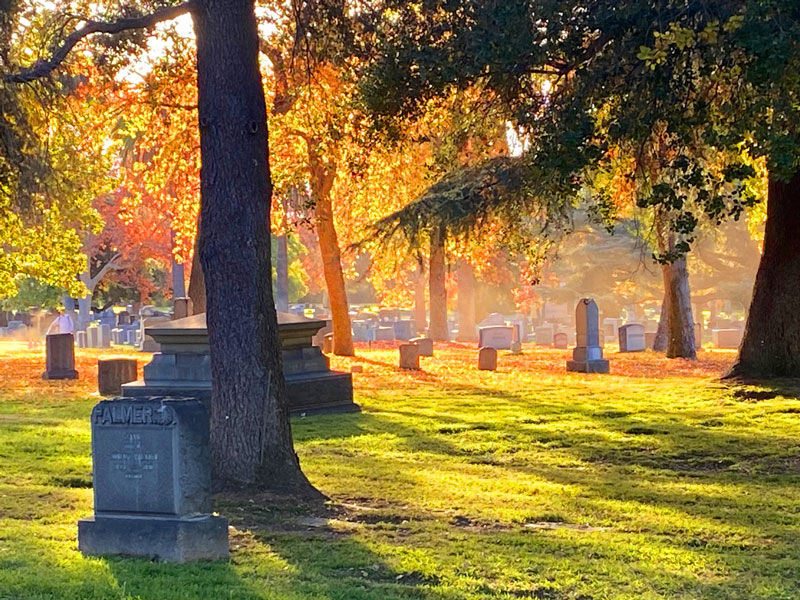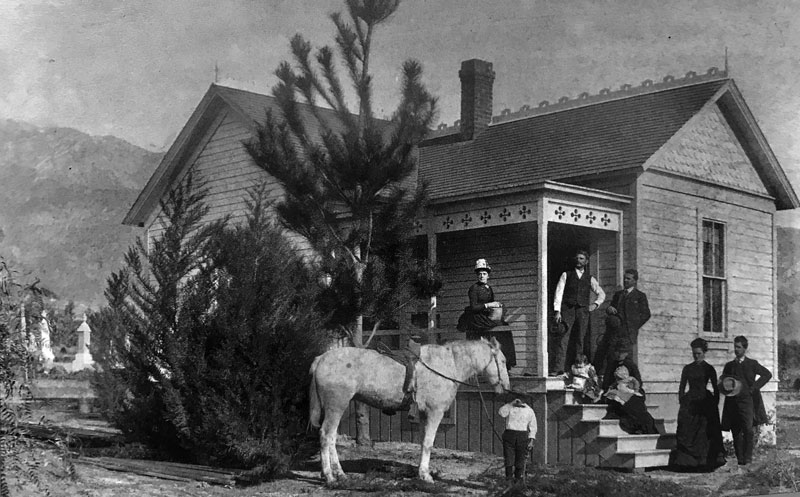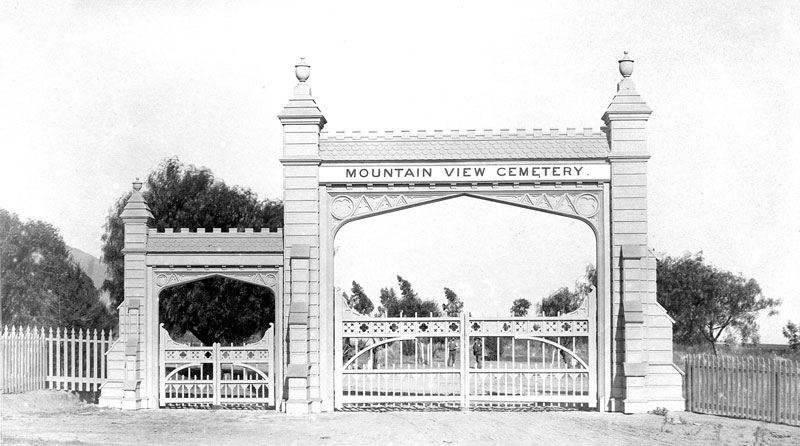The Giddings Family and Mountain View


We are dedicating this issue of our Newsletter to Mountain View Cemetery & Mausoleum, Altadena’s oldest business, established in 1883. In 2023 Altadena Heritage staged a grand party for the centennial of the Mausoleum, Altadena’s most magnificent building. In the following pages we highlight the remarkable lives of of a few of the many who have found final resting places here and in the Cemetery and Mausoleum. Photo: Michele Zack
By Mark Goldschmidt
In the early years of the Indiana Colony that was to become Pasadena, settlers buried their dead in their yards down by the Arroyo. It soon became obvious that this was not working out after a rainy winter when several graves washed out, exposing coffins. Pasadena began forbidding in-town burials.
Levi Giddings, an early settler on future Altadena land saw a need and an opportunity, and set aside 23 acres of the family land for a cemetery three and a half miles north of Pasadena where Raymond Avenue dead-ended into Woodbury, east of the dusty road that was Fair Oaks. With Levi Giddings as president, and with his sons, the Hartwell brothers, E. H. Royce and other members of these inter-married families, they incorporated the Pasadena Cemetery Association. They laid out the grounds in 1882 as a “Park Cemetery”, a style first established in 1831 by the Mount Auburn Cemetery in Cambridge Massachusetts. Prior to Mt Auburn there were no managed cemeteries in the US, only burying gruonds, graveyards, and churchyards. Churchyards had limited capacity, they were smelly and unsanitary; coffins often had to be stacked several high. In the following decades new managed cemeteries were set up in cities all over the US, unaffiliated with any church, always well out of town where a park-like setting could be created.
The Park Cemetery featured curvilinear roadways, lawn, trees, and picturesque vistas — a style emulating the 18th century English Garden then the rage among the manor house set — a landscape of idyllic meadows and groves, a sort of Eden. As the Garden of Eden was walled, so too was the Park Cemetery, fenced off from the mundane world and accessed through an elaborate entry gate. Thus a bucolic landscape was created where remains of the departed could rest undisturbed.
After Altadena was established in 1887, the Pasadena Cemetery was renamed Mountain View. From its inception visitors have been welcome to drive their carriages up from town and pass through the gates, perhaps to park and picnic next to the grave of a loved one. Alternately, visitors could take the trolley running up Raymond from Pasadena terminating at its gates. Within, to this day, it a is pleasant, restful place; it feels special, removed from everyday life. For the first 20 years or so, Mountain View was way up in the country, but even then the cemetery’s looping layout, clipped lawn, and groves of trees contrasted with the surrounding rectilinear roads, orchards, and fields. Now, it’s all paved streets and frame houses, Mountain View is a quiet and cooling expanse of green, welcome in this built-up world, a gift to the neighborhood.
There is a feeling of security in knowing that the dead are contained. We can only visit, and I know that whenever I do, I find that the awareness of being surrounded by the departed leads me to ponder my own mortality. Thinking about our short time on earth is a good way to gain perspective on life and motivation to not waste precious time.

Giddings house at Mountain View Cemetery. The existing gate is just visible on the extreme right.
In the Victorian era, when Mountain View was founded, people were more familiar with death than most of us in the current era. People usually died at home and many died young. Mourning was more ritualized then, with black clothing, homes decorated with black wreathes and draped with black crinoline, mirrors turned to the wall, and formal engraved black-edged funeral invitations sent out. There was great ceremony as the coffin was conveyed to the cemetery, often in a special hearse streetcar. Like weddings, funerals offered a way to attest to a family’s wealth and standing, with somber orations and stone monuments. Celebrations of the life and death of the departed were taken very seriously by middle class Americans.
The 19th century also saw much preoccupation with the paranormal, a prevalent belief in spirits and a feeling that the dead may still be around in some form, and watching, from heaven, hopefully. A proper respectful send-off was important, and so was confidence that a bucolic dedicated space has been provided for them in eternity. Good to keep any stray spirits in there, not out in the living world.
When the cemetery obtained another 30 acres around the turn of the century, and planned to expand, residents objected (of course they did, this is Altadena!), saying that cemeteries were unsanitary (certainly not true of Mountain View). The real objection was fear that a cemetery would depress property values in a growing real estate market. Early attempts to incorporate Altadena as a city were strongly opposed by the Giddings family, who saw that an incorporated city would have the power to stymie expansion plans.
As the new century began, a move to take a more modern approach of memorializing the deceased was called for. In the words of Cecil Bryan, architect and mausoleum builder: “Superstition could be washed away with the new, civilized approaches to sanitation and hygiene.” In the past, mausolea had been built for great men and heroes; now the “Community Mausoleum” was the sensible way to house the deceased in a stately, dignified manner, in a structure for the ages.
No one could say it better than Cecil Bryan, architect of the Mountain View Mausoleum and builder of at least 80 other mausolea across the country: “My goal in building Mountain View Mausoleum was to create the grandest, most artistic mausoleum in the United States. This particular mausoleum is breathtaking in its details: Tiffany stained glass, marble veneers, carved Spanish and Italian ornamentation outside; and inside, elaborate murals depicting scenes from the Old and New Testaments to rival those in the Sistine Chapel. Our ceiling mural took four years to complete.”
With its fortified concrete structure, I wanted it to not only be beautiful, but strong enough to withstand the forces of nature, so that no matter what torrential storms or earthquakes come, this building will be here in a hundred years, and another hundred after that. No constant, fussy mowing of lawns around tombstones required! I invested maximum capitol to create long-lasting, low-maintenance beauty in the public areas of the institution, making spaces everyone would enjoy visiting.“

Mountain View Cemetery gate when it was new.
Mountain View Mausoleum is, indeed, a most beautiful and commodious building, solidly built, no expense spared in 1923. Bryan created a building that would give all who chose a fine tomb, no need to pay a stone mason for a personal monument. It offered convenience ––– visitors can visit no matter the weather –– and awesome beauty ––– magnificent interiors, acres of marble, gorgeous stained glass and artwork. And all quite democratic, one big tomb for all rather than a clutter headstones, monuments, or family crypts. Of course, a variety of sizes and features are offered at prices that denote family status and income.
Mountain View Cemetery, 1882; Mountain View Mausoleum, 1925. As the 20th century progressed, a new kind of cemetery came into style. A change of name, no longer a cemetery, but a “Memorial Park” —- basically a Park Cemetery, but with few monuments or embellishments, streamlined for maintenance with simple identifying slabs flush to the lawn to identify graves. Families are more scattered across the country now, and family plots and tombs have have given way to uniformity; the Memorial Park is arguably more efficient and democratic. Most Americans now die in hospitals, not at home, and the rituals around death prevalent in the past are much abbreviated in our current era. Some wish no lasting memorial, and direct their survivors to have their ashes scattered. Many, however, would like to know where their departed has been laid to rest, enabling the living to visit and to retain a connection to a loved one.
Beyond providing a large, quiet green space in Altadena, Mountain View cemetery and Mausoleum offer views into the history of our community. The tombs and graves in both cemetery and mausoleum are a link to the past, to our pioneer families, our forebears, plus many leading lights, former residents who have given much to our world.
Mountain View opened before our town even had a name, it is the oldest continually operating business in Altadena and still run by descendants of its founders. It remains a thriving business and an integral part of our community. Both the cemetery and the mausoleum are open for visitors daily. They are used regularly for movie shoots, and the Mausoleum lawn is a favored dog exercising spot. The beautiful building contains an art gallery and is open for events; recently Altadena Heritage hosted a fabulous celebration to honor its 100th birthday. May the next 100 years see Mountain View continue to thrive as it welcomes the living as well as the dead.
—-
References for this article:
Ives, Sarah Noble,s, Altadena. Historical & Beautification Society, 1938
Eggener, Keith, quoted by Rebecca Greenfield,
“Our First Parks: the Forgotten History of Cemeteries”. Atlantic Monthly, March 2011
Ford, Emily, Community Mausoleums, Part one: Early 20th Century, Blog by the Oak & Laurel Cemetery Preservation, LLC. 2019
The Altadena Historical Society
Zack, Michele, Altadena, Between Wilderness and City, Altadena Historical Society, 2004.
